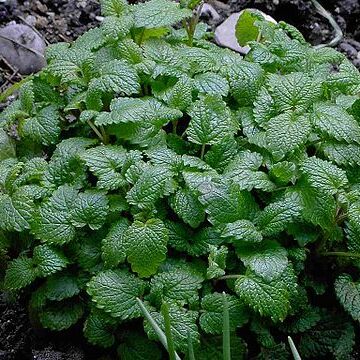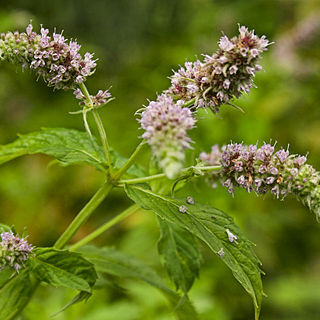Herbs, sometimes subshrubs or shrubs, annual or perennial, usually aromatic. Stems and branches usually 4-angled. Leaves opposite, rarely whorled or alternate, simple to pinnately dissected or compound, without stipules. Inflorescences generally compound, sometimes flowers solitary and axillary; verticillasters 2-to many flowered, subtended by leaves or bracts. Flowers bisexual, zygomorphic, rarely subactinomorphic, bracteolate or not. Calyx persistent, 5-toothed, 2-lipped; upper lip 3-toothed or entire (deciduous in Scutellaria); lower lip 2-or 4-toothed; tube sometimes hairy annulate inside. Corolla limb usually 2-lipped; upper lip 2-lobed and lower 3-lobed, rarely upper lip entire and lower 4-lobed, also rarely limb (4-or) 5-lobed; tube hairy annulate inside. Stamens epipetalous, 4 or 2, free, rarely filaments connate, sometimes one staminodial; anther 1-or 2-celled, usually dehiscing longitudinally; disc persistent. Ovary superior, 2-celled and each cell 2-ovuled and style subterminal, or ovary 4-parted and each lobe 1-ovuled and style gynobasic (from bases of ovary lobes) with 2-cleft apex. Fruit usually 4 dry nutlets. Seeds with or without endosperm.
Gynoecium 2-carpellate, fused to form a pistil; ovary superior, 2-locular but appearing 4-locular due to ovary wall intrusions (false septa), slightly to deeply 4-lobed; ovules 1 in each apparent locule, anatropous, erect, placentation axile (often appearing basal) with ovules laterally attached on the face of the false septum, subterminal (just short of inrolled carpel margins); style 1, gynobasic (arising from central depression of ovary lobes) to terminal, usually bifid at apex; stigmas minute at stylar branch tips
Stamens 4, didynamous (anterior pair longer) or of equal length, or sometimes reduced to 2, epipetalous, free or rarely fused (monodelphic), usually exserted; filaments hairy or glabrous, rarely appendiculate; anthers basi-or dorsifixed, sometimes with a prominent connective, usually with 2-thecae, rarely with one aborted, introrse; thecae dehiscing longitudinally, rarely apically, parallel to divaricate, sometimes confluent at apex or synthecous
Inflorescences terminal or axillary, branched or simple, thyrsoid with determinate cymes arranged along an indeterminate axis, often with paired cymes congested into verticils but sometimes appearing racemose by the reduction of cymes to a single flower, or spicate or capitate by reduction of both the internodes of the inflorescence axis and cyme axes; bracts persistent or not, occasionally coloured; bracteoles present or absent
Flowers zygomorphic occasionally actinomorphic, usually hermaphrodite, hypogynous, usually showy, often with a fleshy nectariferous disk, sometimes resupinate, usually many subtended by a bract, occasionally 1 in bract axils (in reduced cymes), usually pedicellate, rarely sessile
Corolla gamopetalous, tubular, 5-lobed, typically bilabiate with posterior lip 2–4-lobed and anterior lip 1–3-lobed, variously coloured; tube cylindrical, parallel sided, amplified or constricted distally, or saccate below, straight or curved, sometimes annulate within
Fruit a schizocarp splitting into 4 dry nutlets or drupaceous, undivided or 4-lobed with usually 4 pyrenes, sometimes fewer by abortion, subtended by or enclosed within persistent calyx; endosperm present, scant or absent; embryo generally straight, rarely bent
Leaves opposite and decussate or sometimes whorled, very rarely alternate, usually simple rarely pinnately or palmately dissected or compound, usually crenate or serrate, sometimes entire or more deeply toothed, petiolate or sessile, stipules absent
Calyx gamosepalous, actinomorphic to bilabiate, persistent, tubular to broadly campanulate or spreading, sometimes bearded at throat; lobes usually 5, sometimes 2 or 3, and often enlarged in fruit, sometimes closing throat
Ovary superior, of 2 deeply lobed carpels, the style (gynobasic) arising from the inner base of the lobes; stigmas mostly bifid
Flowers hermaphrodite, zygomorphic, rarely almost actinomorphic, axillary, whorled, racemose or paniculate
Stamens inserted in the corolla-tube, 4 or 2; anthers 2-celled, cells often divergent, opening lengthwise
Corolla gamopetalous, hypogynous, tubular; lobes 4-5, imbricate, often forming 2 lips or rarely 1 lip
Seeds with usually straight embryo without endosperm, or the latter very scanty
Calyx persistent, of 5 variously united sepals, often 2-lipped
Annual or perennial herbs, shrubs, or trees, often aromatic
Fruit of 4 achene-like nutlets, free or cohering in pairs
Leaves opposite or whorled, simple; stipules absent
Herbaceous or rarely woody, often odoriferous
Stems frequently square in cross section
Ovules 4 in each ovary, erect
Stems usually quadrangular


